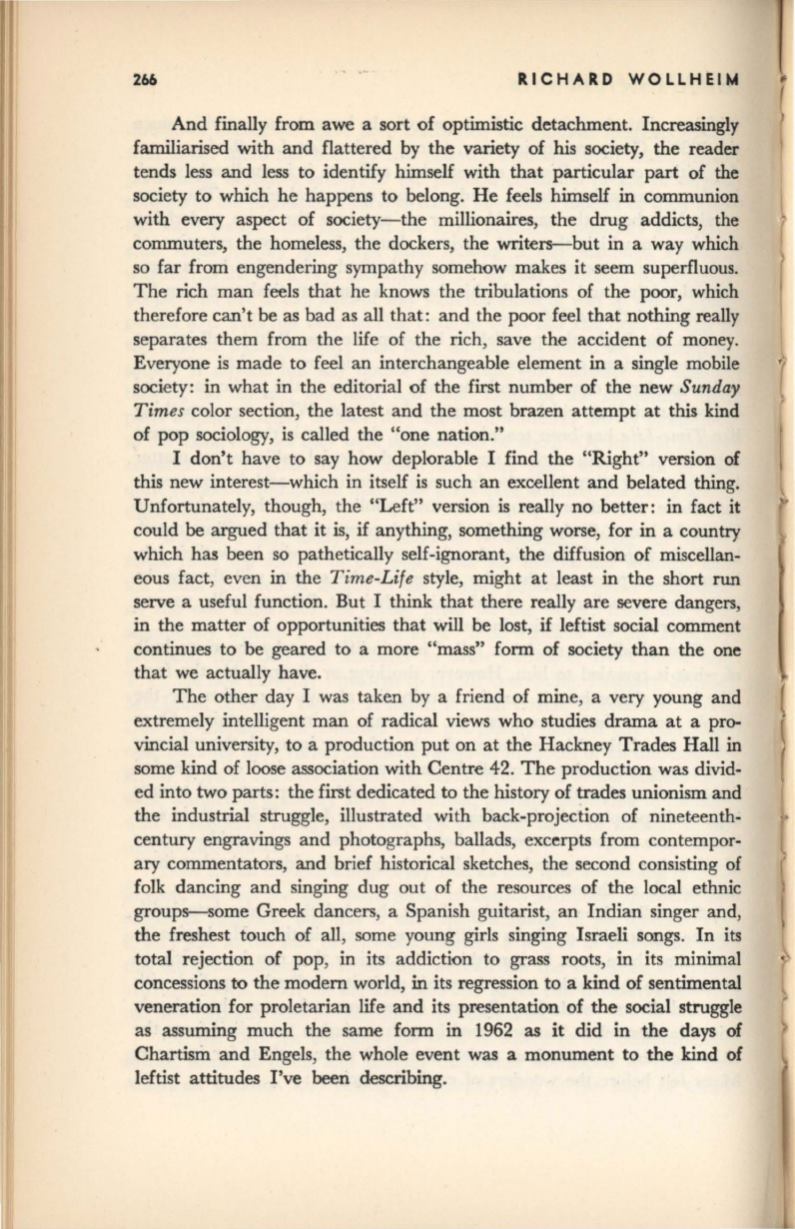
266
RICHARD
WOLLHEltoA
And finally from awe a sort of optimistic detachment. Increasingly
familiarised with and flattered by the variety of his society, the reader
tends less and less to identify himself with that particular part of the
society to which he happens to belong. He feels himself in communion
with every aspect of society- the millionaires, the drug addicts, the
commuters, the homeless, the dockers, the writers-but in a way which
so far from engendering sympathy somehow makes it seem superfluous.
The rich man feels that he knows the tribulations of the poor, which
therefore can't be as bad as all that : and the poor feel that nothing really
separates them from the life of the rich, save the accident of money.
Everyone is made to feel an interchangeable element in a single mobile
society : in what in the editorial of the first number of the new
Sunday
Times
color section, the latest and the most brazen attempt at this kind
of pop sociology, is called the "one nation."
I don't have to say how deplorable I find the "Right" version of
this new interest-which in itself is such an excellent and belated thing.
Unfortunately, though, the "Left" version is really no better: in fact it
could be argued that it is, if anything, something worse, for in a country
which has been so pathetically self-ignorant, the diffusion of miscellan–
eous fact, even in the
T ime-Life
style, might at least in the short run
serve a useful function. But I think that there really are severe dangers,
in the matter of opportunities that will be lost, if leftist social comment
continues to be geared to a more "mass" form of society than the one
that we actually have.
The other day I was taken by a friend of mine, a very young and
extremely intelligent man of radical views who studies drama at a pro–
vincial university, to a production put on at the Hackney Trades Hall in
some kind of loose association with Centre 42. The production was divid–
ed into two parts: the first dedicated to the history of trades unionism and
the industrial struggle, illustrated with back-projection of nineteenth–
century engravings and photographs, ballads, excerpts from contempor–
ary commentators, and brief historical sketches, the second consisting of
folk dancing and singing dug out of the resources of the local ethnic
groups-some Greek dancers, a Spanish guitarist, an Indian singer and,
the freshest touch of all, some young girls singing Israeli songs. In its
total rejection of pop, in its addiction to grass roots, in its minimal
concessions
to
the modern world, in its regression to a kind of sentimental
veneration for proletarian life and its presentation of the social struggle
as assuming much the same form
in
1962 as it did in the days of
Chartism and Engels, the whole event was a monument to the kind of
leftist attitudes I've been describing.
•
I


